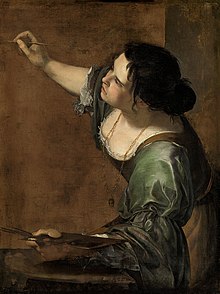Artemisia Gentileschi
kjs on 27th May 2022
Her Early Life
Artemisia Lomi or Artemisia Gentileschi (1593-1653) was an Italian Baroque painter. She was born in Rome, Italy in 1593. Artemisia spen a sheltered childhood, meaning that she spent her time within the four walls of her home. Roman streets were not considered safe for her walk through alone. Artemisia was the eldest child with three younger brothers. At the age of twelve, she became responsible for caring for her brothers when her mother died during childbirth. Artemisia spent her time as an apprentice in her father’s studio. Her father’s paintings became her primary source of inspiration in her early years.

No Academic Education
Artemisia received no academic education until her twenties when finally had the opportunity to read and write. As a child, she enjoyed the privilege of drawing and painting and her talent revealed itself very early in er life. Orazio, her mentor, wrote to one of his patrons saying that Artemisia had become so skilled in three years that she had no peers. She was producing a professional quality of paintings by the age of fifteen. Gentileschi was famous enough to rank among some of the most accomplished seventeenth-century artists. Her reputation started gaining ground recently after the discovery of signature in many of her artful and emotionally charged works. These paintings had earlier been attributed to many male contemporary painters around her.
‘Judith Slaying Holofernes‘, Artists’ Favourite Subject
The story of Susanna and the Elders narrated in the Book of Daniel was a popular subject for artists in the sixteenth and seventeenth centuries. According to the story of Susanna and the Elders, Susanna was a beautiful young women. She was bathing in her garden and two older men spy on her and demand that she submit to rape. This subject became a favourite subject for many artists to paint this theme several times in different versions. Gentileschi painted ‘Susanna Slaying Holofernes‘ in 1610 when she was barely seventeen years old.
‘Susanna and the Elders’
Artemisia Gentileschi’s famous painting ‘Susanna and the Elders‘ was one prominent example of misattribution of her painting to somebody else. The painting is a depiction of two elderly men spying on the young girl Susanna as she bathes. Many old masters like Van Dyck, Rembrandt, Rubens and others had shown keen interest in this painting. All these men painted it varying degrees of interest towards the woman in the painting. None of them succeeded in approaching the topic with as much empathy as Gentileschi did.
Gentileschi’s Version of Susanna
In the version of Gentileschi, two men emerge from behind the balustrade, interrupting Susanna’s routines. The picture shows Susanna raising her hand in an ineffectual attempt at self defense. Susanna also does not want the men to identify her or notice her anguish. The painting mirrors the state of Gentileschi’s mind when she did the painting in her teens.
‘David and Goliath’
The painting ‘David and Goliath’ remained attributed to somebody else until the year 2020. The painting was initially attributed to Giovanni Francesco Guerrieri, a student of Artemisia’s father. After a sort of ‘investigative’ work done by a art historian and a restorer, the painting finally came to be identified with Artemisia in 2020. The painter, Artemisia’s, name painted along the blade of David’s sword solved the puzzle of misconceived identity of the painter in favour of Artemisia.
‘Madonna and Child’
In Roman times, artists painted Virgin alone without the child around. Thereafter, Virgin or Mary came to be portrayed along with the ‘Child’ as a gesture of prayer or reverence to God. Artemisia completed her painting ‘Madonna and Child’ in 1613 when she was around 20 years old. In this painting, Madonna is a representation of Mary, either with or without her child Jesus. This painting has become iconic for bother Catholic and orthodox churches. The word ‘ma donna’ meant ‘my lady’.
‘Judith and Her Maidservant with the Head of Holofernes”
Gentileschi completed her another famous painting ‘Judith and Her Maidservant with the Head of Holofernes” in 1620s. The painting presents the painter’s masterly execution of the technique using light and colour. The characters in this painting and the mid-action of these characters are illuminated by use of a lamplight in a dynamic fashion. In 1611, the year after she painted “Susanna and the Elders”, an artist Agostino Tassi raped her. The savage themes of her paintings have been interpreted as expressions of wrathful catharsis. Given the prevalence of sedual violence against woken, her fascination with these subjects in her paintings is understandable, according to art experts.
Celebrated During Her Lifetime, forgotten later
Gentileschi was one of the first women artists to have achieved success in her career as a painter. Art lovers and fellow artists all over the world celebrated her achievement during her lifetime. Her reputation suffered greatly after her death. The reasons attributed to the decline in her popularity were, firstly, her naturalistic mode of painting that went out of fashion in favour of classical approach. Secondly, her father, Orazio Gentileschi was a well regarded painter and Artemisia’s name appeared only after his name. When some of the experts suggest that they could not name a single artist who followed Artemisia, it points to the fact that no male artist would have acknowledged being her disciple.
Historian Roberto Longhi’s Critical Assessment
Due to these reasons, among others, Artemisia received little critical attention until the early twentieth century. Credit goes to Roberto Longhi, the Italian Art Historian, who made a realistic assessment of the true personality of Gentilischi. He called her “the only woman in Italy who ever understood what painting was, both colors, impasto, and other essentials”. Later, in a landmark survey, ‘Women Artists: 1550-1950’ curated by some famous historians, half a dozen of Gentileshi’s works became a part. He famous work ‘Susanna and the Elders’ was one of them. Thereafter, Gentileschi’s artworks became part of major exhibitions either with or without the works of her well-known father.





